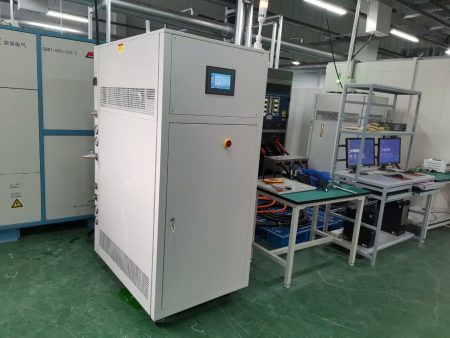Battery Module Cooling
Свяжитесь с нами сегодня, чтобы получить идеальное решение для контроля температуры
In the current technological era, lithium-ion batteries have gradually become the energy source of choice for mobile phones, electric vehicles and energy storage power stations due to their high energy density and long service life.
The battery may have uneven or insufficient power utilization during use, so a battery management system (BMS) is often equipped to monitor and optimize the operating status of the battery. However, with the continuous advancement of technology, battery thermal management (especially temperature control) has gradually received attention. This is because battery temperature that is too high or too low may cause battery performance to degrade and even create safety hazards.
In order to ensure the optimal performance and safety of the battery, an efficient battery thermal management system (BTMS) is indispensable. It ensures that the battery temperature is always within the ideal range and ensures minimal temperature differences between batteries.
It is worth noting that lithium-ion batteries are very sensitive to temperature. For example, battery performance will be affected when the temperature is too low. For certain types of batteries, such as lithium iron phosphate batteries, their conductivity will drop significantly at low temperatures. At high temperatures, batteries may suffer thermal runaway or even cause safety accidents such as explosions.
Cooling technology plays a key role in thermal management, ensuring that battery temperatures do not get too high, thereby protecting the battery and ensuring its safe operation. Although we already have some battery cooling solutions, they still need to be further optimized in terms of heat dissipation, temperature balancing and cost.

Battery module cooling technology
1. Air cooling
Air cooling can be divided into passive natural cooling and active forced cooling. Both methods use air flow to take away the heat generated by the battery to achieve cooling. Its advantages include simple structure, low cost, environmental protection and no pollution.
Natural cooling: This is a passive cooling technology that only requires the design of cooling air ducts. However, this method is difficult to meet the efficient cooling needs of power batteries and may affect the life of the battery.
Forced air cooling: Compared with natural cooling, this technology increases air flow and improves cooling effect by adding fans and other equipment. But it also means increased noise and energy consumption. In addition, by adjusting the shape of the air flow channel, the cooling effect can be further improved.
2. Liquid cooling technology
Liquid cooling uses coolant to heat exchange the battery, dissipating heat efficiently and quickly. This technology is divided into direct liquid cooling and indirect liquid cooling. In direct liquid cooling, the coolant is in direct contact with the battery, such as immersion liquid cooling. Indirect liquid cooling achieves the cooling effect through specific components, such as cooling plates.
Cooling plate liquid cooling
Compared with air cooling, cooling plate liquid cooling technology is more efficient, and cooling plates are mostly made of aluminum or aluminum alloy, and the cost is relatively low. The main research direction is to optimize the structure and fluid flow characteristics of the cooling plate to simplify the manufacturing process and enhance its effectiveness.
Immersion liquid cooling
Immersion liquid cooling technology completely immerses the battery and other heat-generating components in the cooling liquid. Compared with traditional air cooling, this technology reduces noise and energy consumption, and also better controls the temperature of the battery. Despite the excellent results of this technology, its main drawback is the relatively large weight and volume of the system, which limits its application in electric vehicles. But for fixed energy storage power stations, this technology is ideal.
Immersion liquid cooling mainly uses insulating oil and fluorinated liquid as coolant, although the cost is higher. However, research has proven that this cooling technology can ensure that the average temperature rise of the battery does not exceed 5°C, and the temperature difference between cells is only 2°C. This helps improve the service life and safety of energy storage power stations.

3. Phase change material cooling technology
Battery thermal management technology based on phase change materials (PCM) is an innovative method that maintains the battery at an optimal temperature by utilizing the heat storage and release characteristics of PCM. The advantages of this approach are several: it requires no additional energy, is low maintenance, and it does a good job of ensuring a uniform battery temperature.
Currently, the commonly used PCM materials in thermal management are:
Organic materials such as paraffins, alkanes and organic acids.
Inorganic materials such as aqueous solutions, salt hydrates and molten salts.
Eutectic materials.
However, the thermal conductivity of PCM itself is not high, so other materials such as copper foam, expanded graphite and nanoparticles are usually added to improve its thermal conductivity. This can also solve some physical problems of PCM, such as fluidity problems after phase change.
In summary, although PCM shows great potential in battery thermal management, further research and optimization are still needed to ensure its efficiency and safety in practical applications.
4. Thermoelectric cooling technology
Thermoelectric cooling is an advanced active cooling technology. Simply put, when an electric current passes through a specific material, it absorbs heat on one side and releases it on the other, creating a cooling effect. The main advantages of this technology include: no refrigerants, low energy consumption, fast start-up, good stability, low noise and no moving parts. But the disadvantages are also obvious, such as low cooling efficiency and difficulties in manufacturing large equipment.
Мы предоставляем услуги по проектированию и производству систем температурного контроля. От стандартных моделей до полной индивидуальной продукции вплоть до 900 тонн. Мы специализируемся на обслуживании клиентов и стремимся помочь каждому заказчику подобрать оптимальную систему контроля температуры для его конкретных нужд.
Мы предлагаем нестандартные индивидуальные решения. В наличии имеются как чиллеры с одним охлаждением, так и комбинированные агрегаты для охлаждения и нагрева.
Электронная почта: info@lneya.com WeChat ID: +8615251628237 WhatsApp: +86 17851209193

 ЛНЕЙЯ
ЛНЕЙЯ
 简体中文
简体中文


















































































